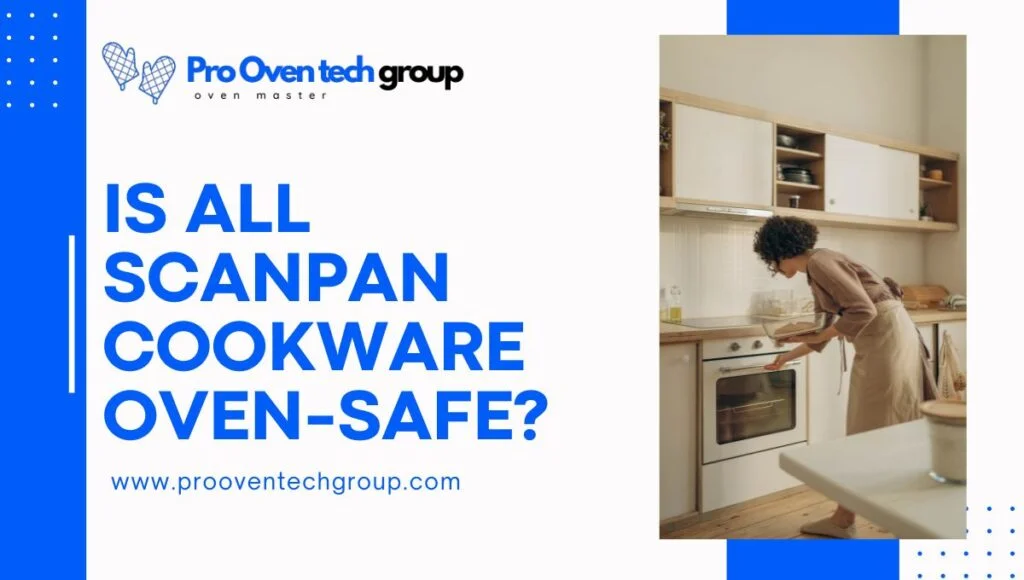Can Scanpan go in oven? When it comes to cooking, having versatile kitchen equipment that can transition from stovetop to oven can make meal prep more seamless and enjoyable. A common question that arises among home cooks and professional chefs alike is whether their preferred cookware, notably Scanpan, is oven-safe.
Yes, Scanpan cookware is oven-safe typically up to 500°F (260°C), making it a versatile choice for recipes that require both stovetop preparation and subsequent baking or roasting.
However, it’s crucial to note that the oven-safety of Scanpan items can be contingent upon the type of line and handle material. Before using a Scanpan in the oven, it is advised to consult the specific product guidelines to confirm the maximum safe temperature and to ensure that it is appropriate for your cooking needs.
Table of Contents
Is All Scanpan Cookware Oven-Safe?

While most of Scanpan’s cookware is designed to be oven-safe, there are exceptions within their product ranges. It’s important for consumers to be wary of non-standard items that might not withstand high oven temperatures.
Each line of Scanpan products, such as the Classic or Professional series, comes with its own specifications. These details include information on oven safety and should always be checked before use.
The construction of Scanpan handles differs across their product lines, with some made from stainless steel and others from plastic materials. Handles built from stainless steel are typically more resistant to oven heat.
To avoid damage or safety hazards, it’s essential to verify your individual Scanpan’s oven compatibility. The user manual or the manufacturer’s website usually provides this vital information.
What Determines Scanpan’s Oven Compatibility?
Scanpan’s oven compatibility is defined by a few core factors including the product line, handle material, lid design, and overall construction quality.
Product Line Variations
Different Scanpan lines have distinct temperature tolerances, reflecting their unique construction and intended use.
Handle Material Resilience
Handles may differ in material; those made from metals like stainless steel usually withstand higher temperatures than plastic counterparts.
Lid Oven-Safety Considerations
Not all lids that accompany Scanpan pots and pans are oven-safe; checking the material and design for oven suitability is crucial.
Construction and Durability
The overall build and materials used in Scanpan cookware determine its ability to endure prolonged or high oven temperatures without damage.
Max Temperature: How Hot Can Scanpan Get?
The maximum temperature a Scanpan can withstand largely depends on its specific product line and construction, generally topping out at 500°F (260°C).
Understanding Scanpan’s Heat Threshold
For each Scanpan series, there is a defined heat threshold that indicates the maximum temperature to which the cookware can be safely exposed while maintaining its integrity and non-stick properties. Exceeding this temperature may compromise functionality and void warranties.
It’s paramount for users to familiarize themselves with their particular Scanpan’s heat threshold, as it differs between product lines like the CTX or Titanium series, and adhere to this limit to ensure the longevity of their cookware.
Variability Among Product Ranges
The diversity among Scanpan’s product ranges underscores the importance of recognizing the varied oven-safe ratings each line holds.
- CTX series pans, for example, are built to withstand higher temperatures than other ranges.
- The Titanium series integrates a unique blend of materials to enhance heat resilience.
Manufacturer’s Guidelines
Always follow the manufacturer’s guidelines to ensure the safe use of Scanpan cookware in the oven.
- Consult the user manual for specific temperature limits.
- Adhere strictly to the advised heat settings.
- Check for updates on manufacturer’s website for any product changes.
Handle Material: A Key Factor in Oven-Use?
The handle material is crucial for determining a Scanpan’s oven safety as it dictates the cookware’s thermal tolerance. Metal handles, especially stainless steel, typically afford higher oven-safe temperatures.
- Metal vs. Plastic: Metal handles can withstand higher temperatures than plastic ones.
- Stainless Steel: Preferred for its durability and higher thermal threshold.
- Safety Precautions: Always use oven mitts when handling hot metal handles.
- Check Specifications: Confirm handle materials in product information before purchasing.
- Lifetime and Care: Proper usage in line with handle material helps extend the cookware’s life.
When evaluating Scanpan cookware for oven use, always consider the handle composition as a pivotal factor for safety and durability.
How to Verify Your Scanpan’s Oven-Safety?
Verifying your Scanpan’s oven safety is straightforward and essential to prevent damage to the cookware or safety issues during cooking.
- Check the User Manual: Look for temperature guidelines and oven-safety confirmations.
- Manufacturer’s Website: See the most current product specifications and user guides.
- Product Line Specifics: Research your particular Scanpan line for its oven-safe ratings.
- Handle and Lid Materials: Identify the types of materials used in handles and lids.
- Contact Customer Service: For any uncertainties, reach out to Scanpan’s support team.
- Look for Oven-Safe Symbols: Usually indicated on the bottom of the cookware.
- Heat Limitations: Acknowledge and adhere to the stated maximum temperature cap.
What About Scanpan Lids in the Oven?

Attention to lid compatibility is as crucial as the pan itself when using Scanpan cookware in the oven. Not all lids are designed to endure high temperatures.
Material Matters
When it comes to oven safety, the construction of Scanpan lids varies, with some made from tempered glass and others from the same durable material as the cookware. Glass lids may have unique temperature thresholds, which are often lower than those of metal lids.
It is imperative for users to check the specifics of their Scanpan lids before placing them in the oven. Typically, lids featuring stainless steel knobs or handles provide a clear indication of higher oven-safe ratings, while plastic components suggest a lower tolerance to heat.
Checking for Indicators
When selecting Scanpan lids for oven use, look for the oven-safe symbol and check if the lid material matches the pan’s heat tolerance.
- Look for Oven-Safe Mark: Usually a symbol or text on the lid.
- Material Consistency: Ensure lid and pan materials are compatible.
- Avoid Plastic Features: Plastic indicates a lower heat threshold.
- Metallic Components: Suggest a higher oven-safe temperature.
- Consult Documentation: Manufacturer’s guidelines provide definitive answers.
Conclusion Can Scanpan go in oven
In conclusion, understanding the oven-safety specifications of your Scanpan cookware is critical to maintaining its quality and functionality. Whether you are a cooking enthusiast or a professional chef, always consult the manufacturer’s guidelines, pay attention to the materials of handles and lids, and acknowledge the temperature limits to ensure that your Scanpan products perform reliably for years to come. Observing these precautions will protect your investment and allow you to continue creating delectable dishes without the worry of damaging your cookware.
FAQS
Q1. Can you put SCANPAN stainless steel in the oven?
A1. Yes, SCANPAN stainless steel cookware is oven-safe up to 500°F (260°C).
Q2. Is SCANPAN grill pan oven safe?
A2. Yes, SCANPAN grill pans are oven-safe up to 500°F (260°C).
Q3. Does Gordon Ramsay use SCANPAN?
A3. Yes, Gordon Ramsay uses SCANPAN cookware in his restaurants and has partnered with the brand for a line of products.
Q4. How long can scanpan go in oven?
A4. The maximum recommended time for SCANPAN cookware in the oven is 1 hour, but this may vary depending on the specific product and its use.
Q5. Scanpan coating coming off?
A5. If you notice any coating coming off, please stop using the cookware and contact SCANPAN’s customer service for assistance. This may be a sign of damage or misuse that could affect the product’s performance and safety. However, with proper care and usage, the non-stick coating on Scanpan products should last for many years.

